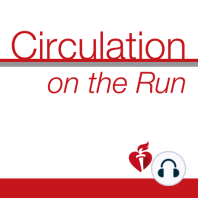20 min listen
Circulation July 16, 2019 Issue
ratings:
Length:
23 minutes
Released:
Jul 15, 2019
Format:
Podcast episode
Description
Dr Carolyn Lam: Welcome to Circulation on the Run, your weekly podcast summary and backstage pass to the journal and its editors. We're your co-hosts, I'm Dr Carolyn Lam, Associate Editor from the National Heart Center and Duke National University of Singapore. Dr Greg Hundley: And I'm Dr Greg Hundley: Hundley, Associate Editor from the Pauley Heart Center in Richmond, Virginia at VCU Health. Well Carolyn, our featured article this week addresses the age at which to initiate clinical screening of relatives for hypertrophic cardiomyopathy. Our guidelines suggest screening of relatives from age ten and onwards but data are lacking to substantiate this suggestion. I look forward to the authors' discussion of their findings regarding initiation of screening in children. For now though, do you have an article that you'd like to share? Dr Carolyn Lam: You bet, Greg. So, the first paper I chose really demonstrates that patients inducible pluripotent stem cells or IPSC cardio derived myocytes can be used as a disease modeling platform to delineate the functional mechanisms that underlie cardiac hypertrophy and in this particular case they looked at Noonan Syndrome and showed that how these techniques can be subsequently used to identify novel molecular and genetic therapeutic targets. So, Greg, here's your quiz. The genetics of Noonan Syndrome. Dr Greg Hundley: I remember it was on our board exam. Dr Carolyn Lam: Let me tell you about it. So more than 90% of patients with Noonan Syndrome have a mutation in the hinge region CR2 domain of Raf-1 and they exhibit severe hypertrophic cardiomyopathy for which there is no treatment. Authors, Dr Jaffrey from Cornell University and Dr Kontaridis from Masonic Medical Research Institute in Utica in New York and their colleagues used Noonan Syndrome Raf-1 patient and CRISPR corrected IPSC cardiomyocytes to recapitulate the Noonan Syndrome cardiac phenotype. These Noonan Syndrome IPSC derived cardiomyocytes exhibited the same hypertrophy and myofibrillar disarray that's really observed in Noonan Syndrome patient hearts, so mechanistically the authors showed that activation of mitogen-activated protein kinase or mech-1 or -2, but not the extracellular regulated kinase, which is ERK1 or 2 triggered abnormal cardiomyocytes structure and conversely ERK5 mediated increased cell size in these Noonan Syndrome mutant IPSC derived cardiomyocytes. RNA sequencing further identified genes dysregulated in the Noonan Syndrome cardiomyocytes that may underlie hypertrophic cardiomyopathy downstream if the mech-1 or -2 and ERK5 genes. Dr Greg Hundley: So, Carolyn, that's a lot of genetic information, so what can I take home as I think about this further and what may come down the line as we manage patients with Noonan Syndrome? Dr Carolyn Lam: Thanks, Greg. The real take home message is that these pathways could serve as novel therapeutic targets to treat hypertrophic cardiomyopathy in patients with Noonan Syndrome and Raf-1 mutations. Overall, the elucidation of rare disease mechanism of hypertrophic cardiomyopathy may further unravel and reveal causes of other more common idiopathic congenital disorders and hypertrophic diseases. Dr Greg Hundley: Oh, very good. Well, I'm going to switch gears and talk a little bit about infective endocarditis prophylaxis and this article comes from Pallavi Garg at the London Health Scientist Center. Carolyn, as you may recall, given the lack of proven efficacy and concerns about the perceived risks of antibiotic prophylaxis like development of antibiotic resistance, the American Heart Association in 2007 and the European Society of Cardiology in 2009 published revised guidelines recommending cessation of antibiotic prophylaxis prior to dental procedures for patients at moderat
Released:
Jul 15, 2019
Format:
Podcast episode
Titles in the series (100)
Circulation December 19/26, 2017 Issue: Circulation Weekly: Your Weekly Summary & Backstage Pass To The Journal by Circulation on the Run
